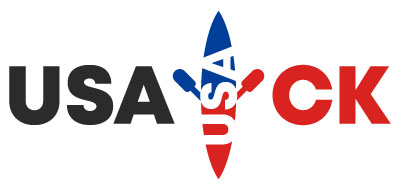Disciplines
Learn the difference between a canoe and a kayak.
Canoe Slalom
In whitewater slalom, athletes have to navigate their canoe or kayak through gates as they work their way through whitewater rapids in the fastest time possible. Hitting one of the hanging gates or missing one completely results in time penalties which are added to the paddler’s time at the end of his or her run.
Canoe Sprint
In sprint canoeing, paddlers race in separate lanes on a straight course in calm water. The International Canoe Federation (ICF) recognizes three different distances: 200m, 500m and 1000m.
Canoe Polo
A team water sport, canoe or kayak polo matches are played with two teams consisting of five players. The teams try to score goals with the water polo ball in a net suspended above the water at either end of the playing “field.” Paddlers use short polo boat kayaks that increase maneuverability and equipment consists of a double-blade paddle, helmets, PFDs and facemasks for safety. Played in two halves of ten minutes each, the game is a fast-paced test of endurance and skill in the water.
Canoe Sailing
Canoe Sailing has a long history, with records of sailing canoes developed in Polynesia over a thousand years ago. In 1886 the American Canoe Association (ACA) and the British Royal Canoe Club (RCC) held the first international sailing regatta. Today, Canoe Sailing involves streamlined canoes that harness their power from large racing sails. Many clubs hold canoe sailing regattas, and canoe sailing also remains as a recreational sport.
Dragon Boat
Originating in China over two thousand years ago, the popularity of Dragon Boat racing has expanded across the globe. The International Dragon Boat Federation is the governing body for the sport and oversees events in over 60 countries.
The long, open canoes are often ornately decorated with a dragon head, scales and a tail. In a large dragon boat approximately 20 paddlers sit in two rows using a single blade paddle. Small dragon boats contain around 10 paddlers, and both configurations use a drummer and coxswain. Events are held on flatwater with distances ranging from 200m to 2000m.
Freestyle (Rodeo)
Freestyle kayaking is a whitewater sport that displays the paddler’s stamina and ability to maneuver. Enjoyed as a recreational sport, freestyle paddlers maneuver down a whitewater course while performing various tricks and spins. Innovations in boat design and construction have increased popularity in the sport, with competitions being held that rank paddlers according to difficulty and style of tricks.
Marathon
Marathon racing involves paddling canoes or kayaks over long distances across flatwater, lakes and rivers. Races can last around three hours and during the race the athlete must carry their boat across portages. Marathons can be held over several days in multiple stages.
Outrigger
Outrigger canoe racing emerged from the islands in the south Pacific and is now growing in popularity. There are multiple sizes of canoe, with seating capacity from one to six people. Sprint races are held with distances ranging from 500m to 3000m and long-distance races can cross up to 30 miles. Outrigger canoes have a pontoon, or ama, attached to the side of the canoe in order to increase stability. Once made out of carved wood, outrigger canoes have been able to increase their speed and maneuverability with lighter fiberglass hulls.
Wildwater
An extremely physically demanding paddlesport, wildwater requires athletes to paddle stretches of whitewater in a ruderless canoe or kayak. There are single kayak (K1) events for men and women and for men, single (C1) and double (C2) canoe events.
